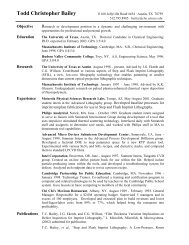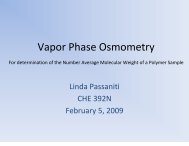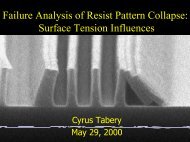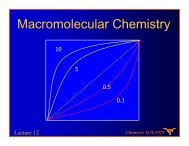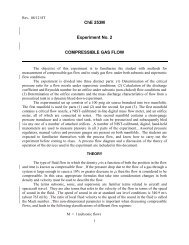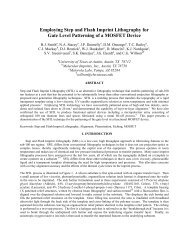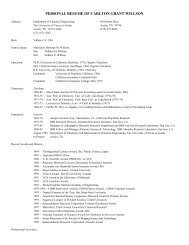Rayleigh Instability of an Annulus
Rayleigh Instability of an Annulus
Rayleigh Instability of an Annulus
You also want an ePaper? Increase the reach of your titles
YUMPU automatically turns print PDFs into web optimized ePapers that Google loves.
Conclusion<br />
It c<strong>an</strong> be seen in both the cases that the critical wavelength (λ c = 2πa) hasn’t<br />
ch<strong>an</strong>ged from the base case (κ = 0). This is in agreement with the surface energy<br />
argument. For a jet <strong>of</strong> cylindrical geometry (κ = 0), the most d<strong>an</strong>gerous mode occurs at s<br />
= 0.6203, α = 0.697, λ = 9*a. The first case where the perturbations are assumed to be<br />
coupled, the wavelength at which this maximum occurs doesn’t ch<strong>an</strong>ge much. However,<br />
it c<strong>an</strong> be seen that the time factor <strong>of</strong> the disturb<strong>an</strong>ce increases as κ is increased (thinner<br />
wall). This corresponds to a faster growing disturb<strong>an</strong>ce. It c<strong>an</strong> be concluded then, that<br />
for a coupled disturb<strong>an</strong>ce (which is the most reasonable assumption for <strong>an</strong> inviscid case),<br />
the jet will break up into droplets <strong>of</strong> equal length as the cylindrical case but it will break<br />
up more quickly.<br />
In the case where the inner wall is stationary, the wall is not <strong>of</strong> uniform thickness.<br />
Figure 4 show that the maximum disturb<strong>an</strong>ce occurs at infinite wavelength as κ is<br />
increased from zero. In this case, the longer wavelength the disturb<strong>an</strong>ce, the more<br />
quickly the disturb<strong>an</strong>ce grows. This case is the less feasible <strong>of</strong> the two cases because in<br />
the case <strong>of</strong> <strong>an</strong> inviscid fluid, there will be a disturb<strong>an</strong>ce imposed on the inner surface.<br />
The former case will most closely approach reality.<br />
References<br />
1. Miller, C., Interfacial Phenomena, Marcel Dekker (1985)<br />
2. Abramowitz, M. <strong>an</strong>d Stegun, I., H<strong>an</strong>dbook <strong>of</strong> Mathematical Functions, Dover<br />
Publications (1965)<br />
6



